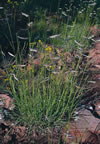| Turf and lawn grasses are
often invasive, require regular maintenance and are
high water users. If closely planted and mowed, the
two native grasses recommended below will resemble
turf. |
 |
Blue grama
Bouteloua gracilis
A low-growing perennial
bunch grass up to 1.5 ft tall with blue-green
foliage. Seed heads appear in summer,
curling when dry to look like eyelashes. Grama grass
grows into an attractive specimen or turf. Wildlife
relish this palatable and nutritious grass. Blue
grama survives heat, drought, and cold. |
Curly mesquite
Hilaria belangeri
A drought tolerant
sod-forming grass which spreads by above-ground
runners, growing up to 12 in tall. It may be hard to
find, try nurseries specializing in native plants.
|
 |
Other features to
consider instead of a grass lawn:
Rockscape, cactus garden, native wildflower
garden, gravel, sand, or artificial turf. |
 |
|